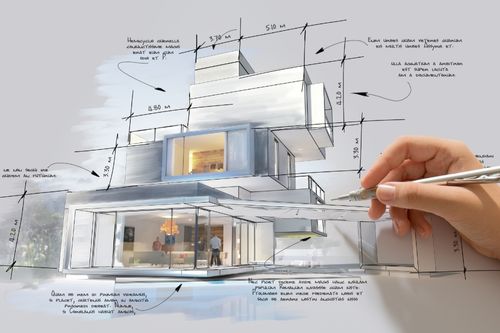Understanding the Collaborative Process Between Engineers and Engineers in Modern Construction Projects
The joint process between engineers and engineers is necessary in modern-day building and construction jobs, as it harmonizes layout intent with design feasibility. Discovering these characteristics exposes understandings that could considerably impact job outcomes and total sector standards.
The Significance of Cooperation
The collaborative synergy in between architects and engineers is essential for the successful understanding of any construction job. This collaboration combines distinctive expertise and viewpoints, enabling the integration of cutting-edge layout with sensible engineering solutions. By functioning together, engineers and designers can guarantee that a task not just satisfies visual and useful demands yet likewise complies with security, sustainability, and budgetary constraints.
Partnership promotes a common vision, facilitating the placement of goals and expectations from the outset. This placement is critical in dealing with potential difficulties and mitigating risks that might emerge throughout the project lifecycle. Furthermore, a collaborative technique permits the reliable allocation of sources, enhancing both time and expense.
The relevance of cooperation encompasses the repetitive procedure of layout and building, where responses from engineers can inform architectural decisions, leading to even more practical and lasting layouts. On the other hand, engineers can influence designers to think artistically concerning exactly how to attain structural stability without endangering creative intent. Eventually, the joint relationship between engineers and designers is not merely advantageous; it is basic to the creation of top quality, practical, and ingenious constructed environments that satisfy the requirements of culture.
Interaction Methods and Tools
Effective interaction strategies and devices are vital for fostering collaboration in between engineers and designers throughout the project lifecycle. Developing clear channels of interaction is vital to ensure that all group members are straightened with job purposes, timelines, and obligations. Normal meetings, both in-person and virtual, offer chances for stakeholders to discuss progress, address concerns, and make informed decisions.
Using job monitoring software program, such as BIM (Building Details Modeling) systems, enhances partnership by allowing real-time sharing of layout modifications and technological specifications. These devices facilitate openness, permitting engineers and engineers to imagine adjustments and assess their effect on the total project.

Shared Objectives and Job Vision

Establishing shared objectives includes open dialogue and a thorough understanding of each self-control's payments. Designers usually concentrate on design intent, spatial relationships, and user experience, while designers highlight structural integrity, systems functionality, and conformity with policies (cda architects). When these viewpoints are straightened, the outcome is a cohesive project that sticks important link to both creative desires and technical usefulness
Moreover, a well-defined project vision cultivates responsibility amongst employee, encouraging each individual to take possession of their duty in achieving the desired end result. Normal check-ins and joint workshops can further strengthen this commitment, enabling modifications to be made as the job advances. Inevitably, a shared vision not only enhances teamwork yet likewise raises the top quality of the last deliverable, bring about effective task conclusion.
The Function of Modern Technology
Leveraging technology has actually ended up being vital in enhancing collaboration in between engineers and designers. Structure Information Modeling (BIM) stands out as a critical modern technology, enabling both engineers and engineers to develop detailed 3D versions that encapsulate layout intent and architectural honesty.
In addition, cloud-based systems make it possible for seamless cooperation, allowing job stakeholders to accessibility and upgrade task data from anywhere. This cultivates a culture of openness and accountability, as modifications can be tracked and reviewed in real-time. In addition, mobile applications additional enhance communication, supplying on-site teams with immediate accessibility to project requirements and updates.
Arising innovations such as synthetic knowledge and artificial intelligence are also starting to play a role in predictive analysis, assisting groups recognize possible issues prior to they emerge. Ultimately, the function of modern technology in architecture-engineering collaboration not only boosts process efficiencies yet additionally boosts innovation, leading to even more effective job outcomes. By accepting these technological innovations, designers and designers can make certain a more cohesive and productive collective process throughout the construction lifecycle.
Study in Effective Collaborations
Countless study highlight the extensive impact of effective collaborations in between architects and designers on job outcomes. One noteworthy instance is the cooperation on the High Line in New York City City, where landscape designers, designers, and urban planners collaborated to change a More Bonuses deserted rail line into a vibrant public park. This multidisciplinary strategy not only boosted the aesthetic quality however also guaranteed architectural safety and environmental sustainability.
An additional excellent case is the design and building and construction of the Sydney Opera House. The collaboration in between engineer JÃ ¸ registered nurse Utzon and structural designer Ove Arup exhibited ingenious analytic. Their partnership enabled the legendary shell-like style while addressing intricate engineering challenges, inevitably leading to a classic architectural masterpiece.
The Burj Khalifa in Dubai even more demonstrates the significance of joint efforts. cda architects. The assimilation of style and engineering know-how allowed the job team to achieve extraordinary heights while adhering to safety and security that site laws and visual vision
These instances highlight the relevance of interaction, trust, and shared objectives. In today's complicated building and construction atmosphere, such collaborations are crucial to navigating challenges and providing tasks that meet both practical and visionary objectives.
Final Thought
In conclusion, the collaboration between designers and engineers is necessary for the success of modern construction projects. Reliable communication strategies, a common project vision, and the assimilation of advanced modern technologies are important parts that promote this partnership.